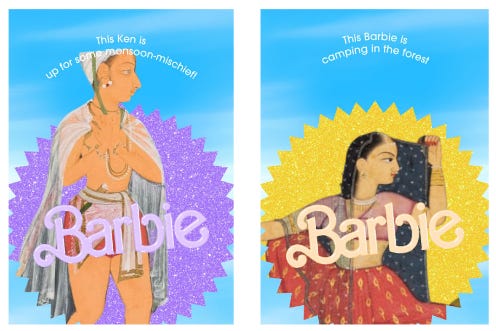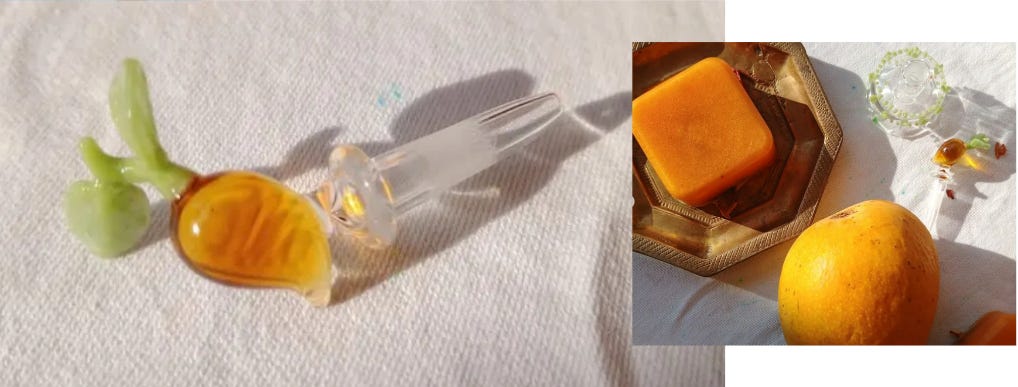I’m an 80s kid from Lagos. Playtime with my Barbie-set opened up a world of imagination in a period beset with political-economic instability and material insecurity. In the midst of electricity and water shortages, the smell of petroleum and fear everywhere, and my own existential struggle, failing in every subject except art that had no merit within the pressure-cooker Indian education system, this plastic-fantastic rainbow-scene expanded my colourful possibilities.
I forgot all about this neon-joy until I saw the new Barbie movie posters circulating online. Their advertising strategy that lets one insert themselves into their AI generated movie poster is marvelous! I thought about the Barbie cake my mom made once, in which she stuck the top half of a doll-body into her upright cake-dress, it was stunning. *As a child I also found joy in cake, and oh! now I realise why I dissociate and disappear into a cake every time things get too intense! - Thanks Freud!*
Now, four points of subversive-possibilities struck me at the same time:
A sudden reconsideration of the idealised portraits and figures painted in South Asian folios and large format multi-perspective illustrations as “Barbies” of the Mughal era.
The Hindu-fundamentalist authority’s latest efforts to erase chapters on Mughal history out of Indian school textbooks — and their perverse view of Urdu as “foreign enemy script” that neatly ties in with my coded reasons for conceptualising a soap last summer that works as a fragrant carrier of an 18th century Urdu verse, that continues to delight a public unafraid of intimacy with this form.
Appropriating and co-opting predictable social media algorithms that open up avenues to insert Mughal era portraits everywhere to counter erasure by way of memes. Here is where the binaries of “Mughal” and “Rajput” can be blurred because our censors do not in fact know which is which. Perhaps these colonial pedagogical categories have done more damage by perpetuating a vocabulary of division so useful for continued extremist politics.
Soap, hand-painted with neon and metallic dyes that deliver that primary colour intensity of 18th century paint pigments! And a tongue in cheek reframing of my project as “Barbie-e Hind: Scent Translations of Mughal and Rajput Barbie Paintings”, just for fun!
Also, the pleasure of upseting sanctimonious snobs and gatekeepers — Priceless!
Perhaps through riding the wave of pop culture, I could entice my public to enter this discourse on visibility through silly ways of pointing out which young prince was out and about on a night of heavy monsoon downpour, which “Ken” among all the beautifully painted personalities in our History-Barbie-exhibition was the handsomest of them all; and which “Barbie” was the most cliché-defying chaotic Boss-babe!

Dumb & Delightful
I am so tired of receiving virtue-scoldings from very-important-people-in-very-important-positions. I feel like I am reliving my childhood all over again. Don’t come into my Barbie-garden just to show off your nicer toys and then refuse to share! And stop plucking my flowers!
Though knowledge and pleasure (art and commerce) are not mutually exclusive, let us exit these venues of performative virtue and get serious about our Playtime and Naptime. Let me invite you to put on your neon pink goggles and joy-ride through our Bagh once more to engage with these 18th century rose-bodied Barbies!
“Naptime in Mughal India” is an actual offshoot I am constructing within this project that plays with pre-colonial material that emphasises the concept of rest. Here, invited scholars contribute a “chapter” through a close reading of a painting or a text, presented in a way that the public can pleasurably absorb - just like my perfume-soap.

Bossy Barbie says…
Look at this detail of an 18th century painting above— does one require “theoretical expertise” to understand fun?!
Two newsletters ago in “Wearable Anger (soap)”, I illustrated the ways in which expertise on art history, is being constructed, owned and controlled. As we now live in an age of massive wealth transfer theft where our essential commons (education, healthcare, environment) are captured by a handful billionaires, even a tax payer funded museum in America behaves like a private one that answers only to its corporate planet poisoning robber-baron overlords mega-donors.
Therefore, which public gets to engage with the aesthetic and intellectual material of pre-colonial India and on what terms, is the real battleground where my thirst for Vengeance-Reparations and Soap Supremacy is far greater than their ability to shape the optics in their favour. So while my virtue-scolders chase their tasteless prestige-cookies, I am here to assert that our currency is colourful-flavourful sparkly fun!

Click on this “Ken” to access the essay “Visual Nosegays: Plants and Scent in Early Modern South Asian Painting” by gardener-scholar-Barbie, Nicolas Roth, where he elaborates on why aristocratic men and women of the pre-colonial period were frequently shown holding flowers or fruit while surrounded by produce, or as surrounded by heaps of roses, jasmine garlands, vases filled with luxurious bouquets of narcissi, and platters of betel leaf and luscious fruit!
Perfumes of the Season: Rose, Imported Cherries, Exported Mangoes ($75/6ml)
Speaking of luscious fruit, “Exported Mangoes” is such a mouthwatering fragrance that captures all the early morning flower garland smells next to the stalls of tea and spices, next to towering crates of mangoes exported out of the country. There are two versions of this perfume: A savoury mango chutney one and a sweet tuberose one. A third version is Raagmala-mango-soap and incense! Don’t choose, pick all four as a Mango-season set!
Soap Supremacy

This Bossy Barbie is very pleased to have become synonymous with the humble sabun (soap), more so than with luxury perfume!

Nothing is more forgiving than this surprisingly artistic medium. Even with my impatience and miscalculations, the result always fills me with awe. As a simulacra of glass, quartz, water, granite, metal or plastic, “soap” creates a perfumed space for my own expressions of anger, silliness and care. The result is always beautiful and is always enjoyed by those who receive it with the understanding that this is an object of meaning, delight and pleasure.







